Current location£ºHome » Hotel&Traffic » Travel

Tour Xiamen
Xiamen is a well-known tourist port city in the Southeast coast of China. It is one of the Cleanest Cities of China, the Garden Cities of China, the National Environmental Protection Model Cities, and the best sightseeing cities in China. Not only being wealthy with travel resources, Xiamen has also temperate weather, fast and convenient transport and communication, and complete travel establishments.
In the old times, there were "Eight Major Landscapes" and "Eight Minor Landscapes" "Landscapes Beyond Landscapes" in Xiamen and altogether 24 scenic spots were included in the three general terms. Some of the 24 sights, such as "Wonderland of Gulang", "Five Old Gentlemen Reaching the Clouds", "Watching Sunrise on Hongji Summit", "Night Moon by Tiger Brook", "White Deer Spurting Smoke", still can be traced today.
By reorganizing old landscapes and developing new sceneries, Xiamen has formed five main Tourist areas-- Gulangyu Island Tourist Area, Nanputuo Temple Tourist Area, Wangshi Rock Tourist Area, Huangcuo Tourist Area and Jimei Tourist Area. Beside its richful travel resources and pleasant weather, Xiamen also provides fast and convenient transportation and communication, and complete travel establishments. All makes Xiamen one of the most suitable cities for investors and tourists in China.
Gulangyu, separated from Xiamen by the 500-metre-wide Egret River, with an area of 1.77 square kilometres, enjoys a lauditory title "Garden on the Sea." The original name of the islet was Yuan Zhou Zi. In the Ming Dynasty it was renamed Gulang, meaning ''drum waves", because the holes in the southwestern reefs hit by the waves make sounds like the drum beating.
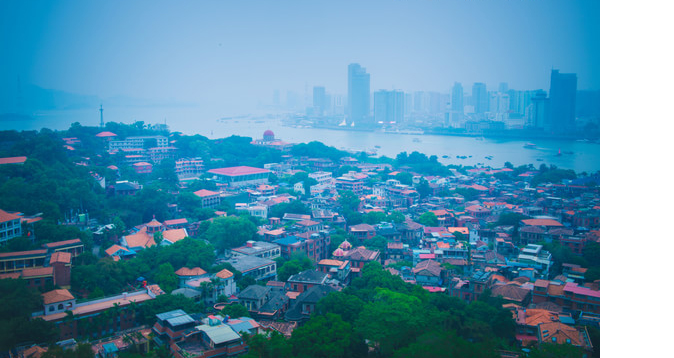
Overlapping peaks foil the blue water, white clouds, green trees and bright flowers. The air in the islet is fresh. The entire place is free from any sorts of vehicles and is particularly quiet. All these render an atmosphere of a fairyland.
No tourist can afford to miss one attraction located on the island -- the nation's largest piano museum. Divided into two exhibition halls, the museum guides visitors through a vivid history of the instrument with displays and illustrations. All different types of pianos such as miniature pianos, automatic pianos, accordion pianos and round-shaped pianos, are on display.
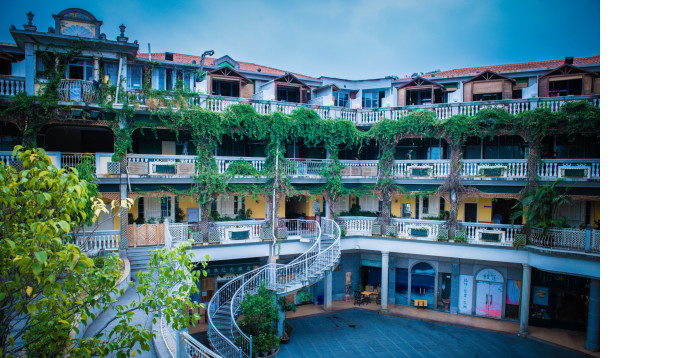
The architecture in the islet varies greatly in style, Chinese and foreign. Thus the islet has a laudatory title "the World Architecture Museum" Covered in green all the year round, it's charming, elegant, secluded and serene. A great variety of villas stand shrouded by lush wood resembling numerous jadeites embellished upon a piece of verdant silk brocade. Hundreds of flowers grown on the Riguang Rock (Sunlight Rock) vie with one another for beauty. With the caressing sea breeze, it's a quite cool place in hot summer. At the foot of the rock, there's the Memorial Hall to honor the national Hero Zheng Chenggong.
Today, Gulangyu is listed as one of the nation's major scenic spots. The main sites of interest here include the Sunlit Rock, Shuzhuang Park, Gangzihou Bathing Beach and Memorial Hall to Zheng Chenggong, which are visited annually by millions of people from all parts of the country and the world. For people living in the hustle and bustle of today's metropolis, citizens on this island seem to live in a paradise with a relaxing, healthy and placid lifestyle. Find more in our detailed introduction of the major attractions in Gulangyu Tourist Area.
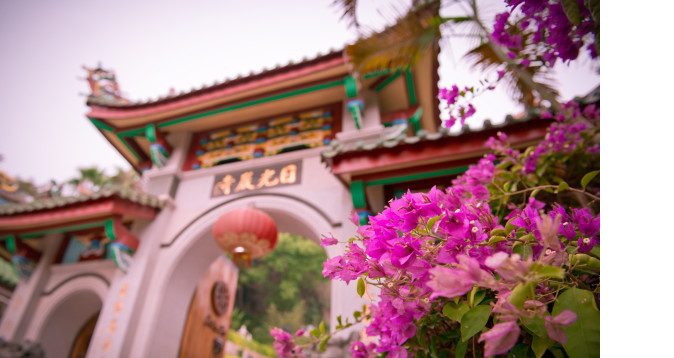
City Bird-Egrets
Egrets are the world's rare birds. They belong to heron family of bird class. Xiamen boasts small egrets, middle egrets, large egrets, Chinese egrets and gray egrets, which dwell are the only five types of herons ever seen in China. People choose to call them egrets (Bailu in Chinese) collectively because they, except the gray egrets, which have dark gray body-feathers, have beautiful snow-white feathers. The small and midium-sized egrets are of the largest numbers and are seen more frequently. On October 23 of 1986, at the 23rd Session of the Standing Committee of the 8th Municipal People's Congress it was decided that the egret be the City Bird of Xiamen.
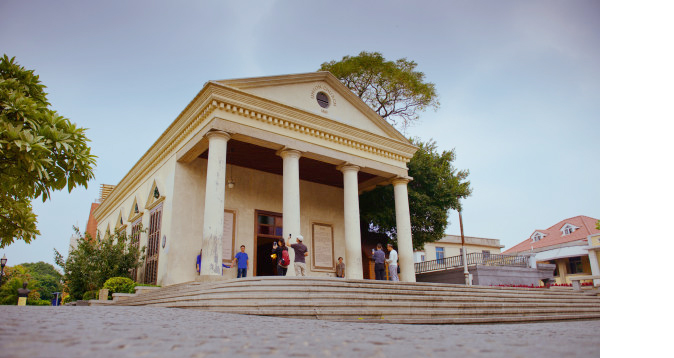
City Flower-Bougainvillea glabra
The City Flower was decided by the Standing Committee of the Eighth People's Congress of Xiamen City on October 23, 1986 in its 20th conference. The scientific name of the flower is Bougain Villeasp. It is an evergreen clamber bush or a hanging down shrub, which belongs to the category of bougain of the bongainvillea family. It is a wood nature liana. The nature of its leaves has the luster. Its flower is small and blooms on the top. The flower usually grows in clusters in the bud plate. The three big bud plates are very distinctive, constructing a major object sight for enjoying. In ancient times, it was called "Nine Layers of Vine". It is called "Leaves Tiny Flower" and "Triangular Flower" in North China and it was called "Bougain" as translated in sound from English in Hongkong. It was originally planted in Brazil of South America and it is a long time since it was imported and planted in China in 1972.
It has a great number of varieties, and large amount of colors. It has the nurture color of red, orange, yellow, white and purple, and it has the shape of single petal flower, double petal flower and mottled plate flower etc. It couples hardness with softness, and it is simple and unadorned. It is easy to plant and possesses such variety of colors, so it can be used to make potted landscape. As a result, to use the Triangular Shaped Plum Blossom as the city flower, to plant it broadly and to take care of it will not only afforest and beautify Xiamen, but also better show the style and features of Xiamen, the character of Xiamen people and the rapid Development of the Xiamen Special Economic Zone.
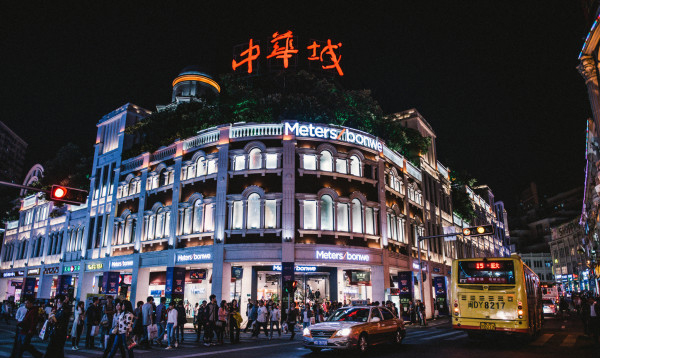
Nanputuo Temple
Situated at the foot of Wulao Peak on the southern end of Xiamen is nanputuo Temple. The temple's Heavenly King Hall, the main prayer hall, the Hall of Great Compassion and the Shrine of Buddhist Scriptures are all graced with painted brackets.
The temple was first built during the Tang Dynasty (618-907). And rebuilt during the Qing Dynasty (1644-1911), it is now an imposing multi-layered trapezoidal structure that overlooks the sea. The Shrine of Buddhist Scriptures houses a huge collection of Buddhist cultural relics, including a Burmese jade carving of the Buddha and many important Buddhist literature. It is one of the sacred places of Buddhism in Southern Fujian. Inside the temple there are the Heaven King's Hall, the Daxiong Hall, the Great Compassion Hall, all of which are built in an exquisite and grand style.
Enshrined in these halls are the statues of Maitreya, Sanshi Reverend Buddha, Thousand-handed Guanyin (Bodhisattva), Four Kings of Heaven, and the eighteen arhats. Although all are serious and solemn in appearance, each is distinctly different from another. The temple attracts a large number of pilgrims at home and abroad. The excellent craftsmanship of the Thousand-handed Guanyin is marked by its thousand hands and thousand eyes and glistening golden color.
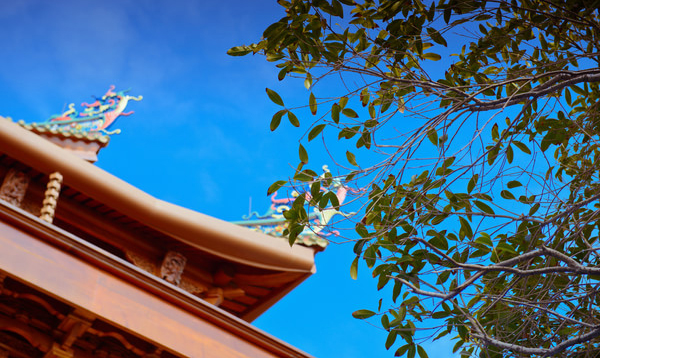
As to the Pavilion where Buddhist scriptures are kept, it has a rich collection of the historical articles of Buddhism. such as classics, statues of Buddhas, bronze bells from the Song Dynasty, calligraphic works and paintings from the ancient times. Among them, "Intriguing Lotus Scripture" written in blood in the Wanli period of the Ming Dynasty and the statue of Guanyin in white porcelain, a masterpiece of He Chaosong, are most valuable.
In the temple are preserved many inscriptions, among which the stone inscriptions written by Chen Di and Sheng Yourong in the Wanli period of the Ming Dynasty and the one on a stone stele written by Emperor of the Kangxi period of the Qing Dynasty are most famous. Behind the temple, inscribed on the wall of a rock is a large word "Buddha" which is 4.66 metres in height and 3.33 metres in width. And farther behind, high up on the mountain stands a screen of five peaks coloured by green trees and bamboos and marked by serene valleys and rocks of pleasing shapes. They are called "Five Old Gentlemen Reaching the Clouds," and are one of the eight grand sights of Xiamen. Coming to the top, you not only have a view of the mountain undulating in the wind, but also the view of the sea surging in the distance.
